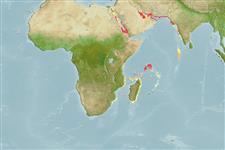>
Gobiiformes (Gobies) >
Gobiidae (Gobies) > Gobiinae
Etymology: Ctenogobiops: Greek, kteis, ktenos = comb + Latin, gobius = gudgeon + Greek, ops = appearance (Ref. 45335).
Environment: milieu / climate zone / depth range / distribution range
Écologie
marin récifal; profondeur 1 - 20 m (Ref. 86942), usually 1 - 5 m (Ref. 27115). Tropical; 22°C - 28°C (Ref. 27115)
Western Indian Ocean: Red Sea.
Taille / Poids / Âge
Maturity: Lm ? range ? - ? cm
Max length : 6.7 cm SL mâle / non sexé; (Ref. 90180)
Épines dorsales (Total): 7; Rayons mous dorsaux (Total): 11; Épines anales 1; Rayons mous anaux: 11. This species is distinguished by the following characters: D VI + I,11-11; A I,11; pectoral rays 18-19; longitudinal scale series 58-66; body depth 5-5.6 in SL; dorsal profile of snout forming an angle of about 60° to horizontal axis of head and body; gill opening reaching forward to, or slightly anterior to, a vertical at posterior margin of preoperculum; 2nd dorsal spine longest (in males 1.2-2.2 times longer than third spine; while in females 1.2-1.6 times longer than third spine); caudal-fin length 2.8-3.6 in SL; 4 longitudinal rows of dark brown spots on body, the first 3 with dashes alternating with small spots, lowermost of 7 or 8 round to slightly oval spots (3rd one small); postorbital head crossed by 4 steeply oblique rows of dashes and spots, 1st short from behind eye, 2nd from behind corner of mouth to above anterior fourth of opercle; snout with a V-shaped dark brown mark dorsoposterior to it; when alive, the ventral part of body with small vertical yellow marks, mostly over abdomen and pectoral fins with a white spot at upper base and a larger one near middle of fin about one-third fin length from base (Ref. 90180).
Found in coarse sand and rubble bottoms of coastal reefs in 1-15 m (Ref 90102).
Life cycle and mating behavior
Maturité | Reproduction | Frai | Œufs | Fécondité | Larves
Kovačić, M., S.V. Bogorodsky and J.E. Randall, 2011. Redescription of the Red Sea gobiid fish Ctenogobiops maculosus (Fourmanoir) and validation of C. crocineus Smith. Zootaxa 3054:60-68. (Ref. 90180)
Statut dans la liste rouge de l'IUCN (Ref. 130435)
Menace pour l'homme
Harmless
Utilisations par l'homme
Aquarium: Commercial
Plus d'informations
Noms communsSynonymesMétabolismePrédateursÉcotoxicologieReproductionMaturitéFraiRassemblement de ponteFéconditéŒufsDéveloppement de l'œuf
RéférencesAquacultureProfil d'aquacultureSouchesGénétiqueElectrophoresesHéritabilitéPathologiesTraitementNutrientsMass conversion
Outils
Articles particuliers
Télécharger en XML
Sources Internet
Estimates based on models
Preferred temperature (Ref.
123201): 26.2 - 29.2, mean 27.5 °C (based on 329 cells).
Phylogenetic diversity index (Ref.
82804): PD
50 = 0.5020 [Uniqueness, from 0.5 = low to 2.0 = high].
Bayesian length-weight: a=0.00708 (0.00333 - 0.01504), b=3.09 (2.92 - 3.26), in cm total length, based on LWR estimates for this (Sub)family-body shape (Ref.
93245).
Niveau trophique (Ref.
69278): 3.4 ±0.4 se; based on size and trophs of closest relatives
Résilience (Ref.
120179): Haut, temps minimum de doublement de population inférieur à 15 mois (Preliminary K or Fecundity.).
Fishing Vulnerability (Ref.
59153): Low vulnerability (10 of 100).
Nutrients (Ref.
124155): Calcium = 179 [79, 370] mg/100g; Iron = 0.864 [0.440, 1.704] mg/100g; Protein = 17.9 [15.9, 19.6] %; Omega3 = 0.0949 [, ] g/100g; Selenium = 22.3 [9.8, 52.1] μg/100g; VitaminA = 147 [38, 525] μg/100g; Zinc = 2.36 [1.50, 3.59] mg/100g (wet weight);
